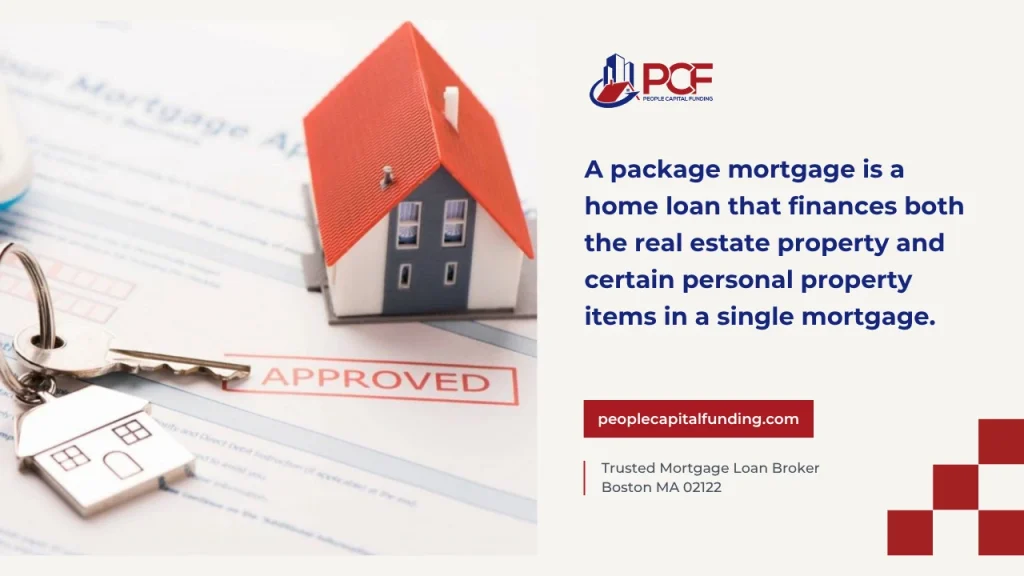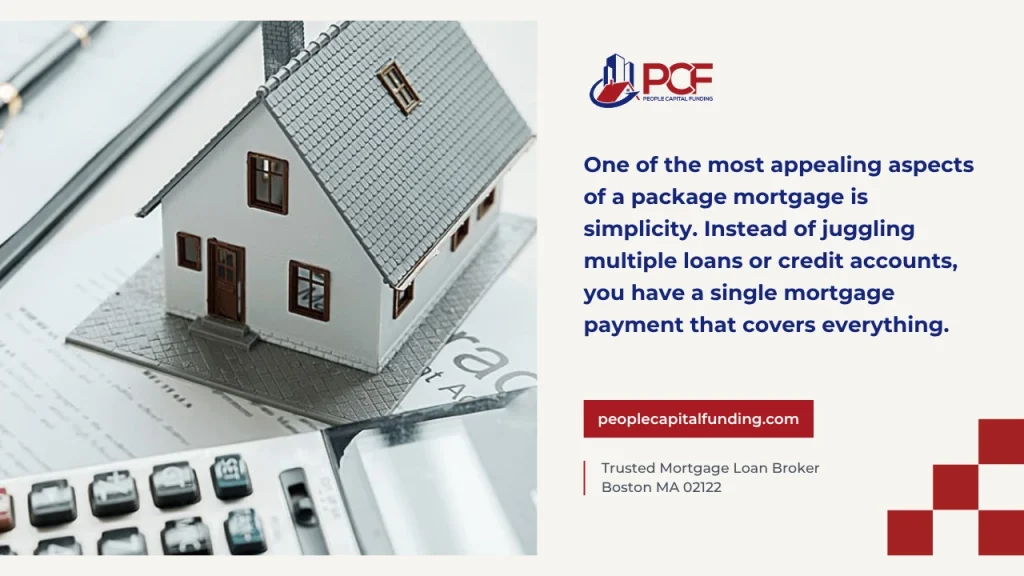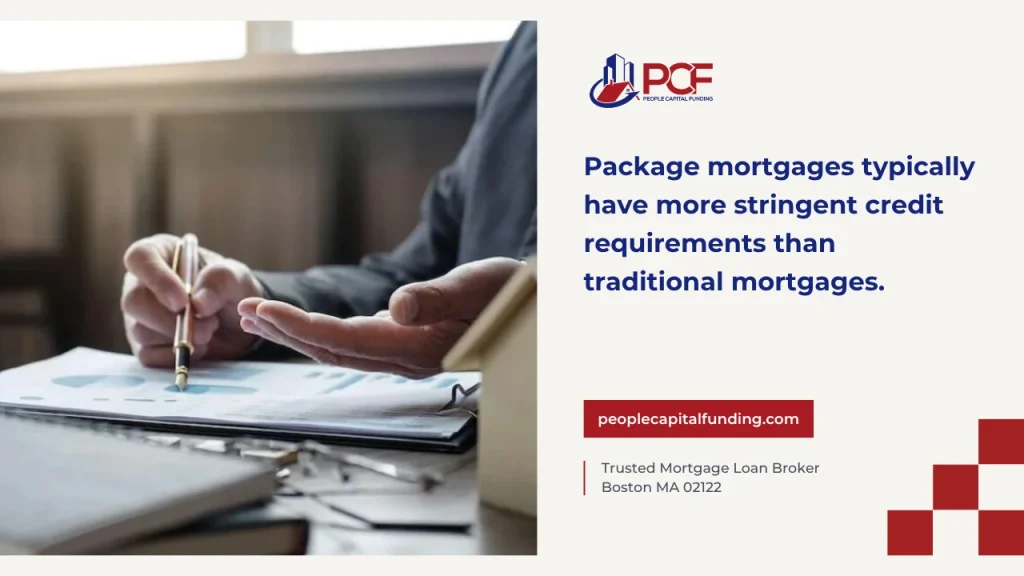
A package mortgage is a home loan that finances both the real estate property and certain personal property items in a single mortgage. This type of loan allows homebuyers to include the cost of household items, fixtures, and even some property improvements in their mortgage rather than paying for these items separately. For example, when purchasing a home, you might want to include appliances, furniture, or even equipment like pool maintenance systems in your financing package.
Unlike traditional mortgages that only cover the real property (the house and land), package mortgages extend coverage to personal items that would typically require separate financing. This consolidated approach can simplify the homebuying process for many buyers, especially first-time homeowners who might not have additional funds available after making a down payment. But like any financial product, package mortgages come with their own set of considerations that buyers should carefully evaluate before signing on the dotted line.

What Items Can Be Included in a Package Mortgage?
Common Household Items and Fixtures
When considering a package mortgage, you might wonder exactly what personal property can be included. Most lenders allow for the inclusion of:
- Major appliances (refrigerators, washers, dryers, ovens)
- Window treatments (blinds, curtains, shutters)
- Built-in electronics (home theater systems, security systems)
- Furniture (in some cases)
- Outdoor equipment (lawn mowers, snow blowers)
These items are typically those that enhance the functionality of the home but aren’t permanently attached to the property. A good rule of thumb is that if you can take it with you when you move, it might qualify for inclusion in a package mortgage.
Property Improvements That Qualify
Beyond movable personal property, package mortgages can sometimes cover immediate improvements you plan to make after purchase:
- Kitchen renovations
- Bathroom upgrades
- Flooring installations
- Energy-efficient upgrades (solar panels, new HVAC systems)
- Landscaping projects
The key distinction here is that these improvements should be planned for immediate implementation after closing. Lenders typically want to see quotes from contractors and detailed plans before approving these costs in the package.
Special Considerations for New Construction
Package mortgages are particularly useful in new construction scenarios. When buying a newly built home, you might find yourself needing to purchase numerous items all at once:
- Appliances not included by the builder
- Window coverings for every window
- Landscaping for a bare yard
- Fencing for property boundaries
- Outdoor living spaces like patios or decks
Builders often deliver homes with minimal amenities, expecting buyers to customize according to their preferences. A package mortgage can help spread these initial setup costs over the life of the loan rather than requiring large upfront expenditures.
Benefits of Choosing a Package Mortgage
Single Financing Solution Advantages
One of the most appealing aspects of a package mortgage is simplicity. Instead of juggling multiple loans or credit accounts, you have a single mortgage payment that covers everything. This streamlined approach offers several advantages:
- One application process
- One closing
- One monthly payment
- One interest rate to track
- Simplified record-keeping for tax purposes
For many homebuyers, especially those with busy schedules or limited experience with complex financial arrangements, this simplicity can be worth its weight in gold.
Potential Interest Savings
Package mortgages can potentially save you money compared to alternative financing methods. Consider this scenario:
If you finance appliances and furniture on a credit card with a 17% interest rate or through store financing at 12-24%, you’ll likely pay significantly more in interest than if those same items were included in your mortgage at 5-7% (depending on current rates).
Additionally, mortgage interest typically has a longer amortization period than consumer credit, which can further reduce your monthly payments, though you’ll be paying for these items over a much longer period.
Tax Implications and Benefits
The tax advantages of package mortgages can be substantial for some borrowers. Since mortgage interest is often tax-deductible (consult with a tax professional regarding your specific situation), including personal property in your mortgage might increase your potential deductions.
Items that would normally be purchased with after-tax dollars using consumer credit might effectively become tax-advantaged when included in your mortgage. However, this benefit has become less significant for many borrowers following recent tax law changes that raised the standard deduction, making itemizing less advantageous for some taxpayers.

Potential Drawbacks of Package Mortgages
Higher Overall Loan Amount Considerations
While consolidating purchases into your mortgage seems convenient, it does increase your total loan amount. This has several implications:
- Higher down payment requirements
- Potentially higher mortgage insurance premiums
- Increased total interest paid over the life of the loan
- Greater overall debt burden
For example, adding $20,000 in personal property to a 30-year mortgage means you’ll be paying interest on those items for three decades, long after their useful life has ended.
Depreciation Factors of Included Items
Unlike real estate, which typically appreciates over time, personal property depreciates—often rapidly. This creates a financial mismatch that can be problematic:
- You might be paying for items years after they’ve been replaced
- The value of the items will decline while your loan balance decreases more slowly
- This can create an “underwater” situation specifically for the personal property portion of your loan
This depreciation factor is one of the strongest arguments against including short-lived items in a long-term mortgage.
Qualification Challenges
Lenders are often more cautious about package mortgages because they include non-real estate assets:
- Some lenders don’t offer package mortgages at all
- Those that do may charge higher interest rates
- Appraisals become more complex, involving both real estate and personal property
- Loan-to-value calculations may be affected, potentially requiring larger down payments
These additional hurdles can make the mortgage application process more challenging and might limit your options when shopping for lenders.
How to Qualify for a Package Mortgage
Credit Requirements
Package mortgages typically have more stringent credit requirements than traditional mortgages. Since the lender is taking on additional risk by financing depreciating assets, they generally look for:
- Credit scores of 680 or higher (compared to minimums of 620 for many conventional loans)
- Clean credit history with minimal late payments
- Established credit history showing responsible management of various debt types
The better your credit profile, the more likely you are to qualify for favorable terms on a package mortgage.
Income and Debt-to-Income Considerations
As with any mortgage, your income and debt-to-income (DTI) ratio play crucial roles in qualification:
- Stable, documentable income
- DTI typically not exceeding 43% (though some lenders may allow higher ratios)
- Reserve funds beyond the down payment
Because package mortgages result in higher loan amounts, lenders want to ensure you have sufficient income to manage the increased payment comfortably.
Property Appraisal Factors
The appraisal process for package mortgages is more complex than for traditional mortgages:
- Requires valuation of both real estate and personal property
- May require specialized appraisers with expertise in various types of personal property
- The condition of existing personal property (in purchase scenarios) will be scrutinized
- Lenders may have limits on what percentage of the total loan can be for personal property
These appraisal complexities can add time and expense to the mortgage process, so factor this into your homebuying timeline.

Package Mortgages vs. Other Financing Options
Comparison with Traditional Mortgages
To help you understand the differences, here’s a comparison between package mortgages and traditional mortgages:
| Feature | Package Mortgage | Traditional Mortgage |
|---|---|---|
| What’s covered | Real estate + personal property | Real estate only |
| Typical interest rate | Slightly higher | Market standard |
| Loan term | 15-30 years for everything | 15-30 years |
| Down payment | May be higher | Standard (3-20%) |
| Qualification difficulty | More stringent | Standard |
| Availability | Limited lenders | Widely available |
| Tax deductibility | Potentially more deductible interest | Standard mortgage interest |
This comparison highlights that while package mortgages offer convenience, they come with trade-offs in terms of cost and availability.
Alternatives Such as Personal Loans for Additional Items
Before committing to a package mortgage, consider these alternatives:
- Traditional mortgage + personal loan: Use a conventional mortgage for the home and a separate personal loan for major purchases. Personal loans typically have higher interest rates but shorter terms (3-7 years), so you’ll pay off the items during their useful life.
- Traditional mortgage + 0% introductory APR credit cards: For buyers with excellent credit, using credit cards with promotional 0% interest periods (often 12-18 months) can be cost-effective for initial purchases.
- Cash purchases after saving: The most financially sound approach is often to buy only what you can afford with cash after purchasing the home, even if it means waiting to furnish certain rooms.
- Retailer financing: Many furniture and appliance retailers offer special financing, sometimes with deferred interest promotions that can be advantageous if paid off during the promotional period.
Each alternative has its own risk-reward profile that should be evaluated based on your financial situation and priorities.
Home Equity Options After Purchase
If you choose a traditional mortgage initially, you can still leverage your home’s equity for major purchases down the road:
- Home equity loans provide lump sums for major purchases after you’ve built equity
- Home equity lines of credit (HELOCs) offer flexible borrowing options
- Cash-out refinancing allows you to replace your existing mortgage with a larger one and take the difference in cash
These options give you the flexibility to finance personal property later, often when you have a better sense of your needs and preferences after living in the home.
Conclusion
Package mortgages offer a convenient way to finance both your home and necessary personal property with a single loan. They can simplify the homebuying process and potentially save on interest compared to high-interest consumer financing options. For buyers who need to furnish a home from scratch or make immediate improvements, the ability to spread these costs over the mortgage term can make homeownership more accessible.
However, these benefits come with significant trade-offs. You’ll likely pay more interest over time, face stricter qualification requirements, and continue paying for items long after they’ve depreciated or been replaced. The higher loan amount also means a larger debt burden and potentially higher monthly payments.
Before deciding on a package mortgage, carefully assess your financial situation, long-term goals, and alternatives. For many buyers, a traditional mortgage combined with strategic use of savings, personal loans, or promotional financing offers a more balanced approach. Ultimately, the right choice depends on your unique circumstances, tolerance for debt, and financial priorities.
